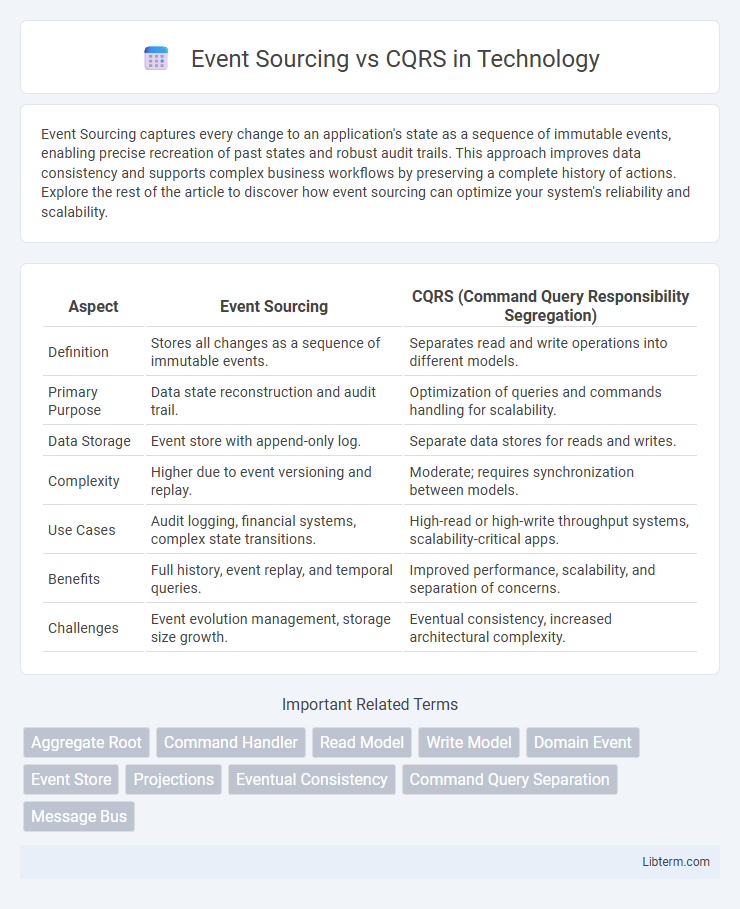Event Sourcing captures every change to an application's state as a sequence of immutable events, enabling precise recreation of past states and robust audit trails. This approach improves data consistency and supports complex business workflows by preserving a complete history of actions. Explore the rest of the article to discover how event sourcing can optimize your system's reliability and scalability.
Table of Comparison
| Aspect | Event Sourcing | CQRS (Command Query Responsibility Segregation) |
|---|---|---|
| Definition | Stores all changes as a sequence of immutable events. | Separates read and write operations into different models. |
| Primary Purpose | Data state reconstruction and audit trail. | Optimization of queries and commands handling for scalability. |
| Data Storage | Event store with append-only log. | Separate data stores for reads and writes. |
| Complexity | Higher due to event versioning and replay. | Moderate; requires synchronization between models. |
| Use Cases | Audit logging, financial systems, complex state transitions. | High-read or high-write throughput systems, scalability-critical apps. |
| Benefits | Full history, event replay, and temporal queries. | Improved performance, scalability, and separation of concerns. |
| Challenges | Event evolution management, storage size growth. | Eventual consistency, increased architectural complexity. |
Introduction to Event Sourcing and CQRS
Event Sourcing captures all changes to an application state as a sequence of immutable events, enabling precise audit trails and state reconstruction. CQRS (Command Query Responsibility Segregation) separates read and write operations into distinct models, optimizing performance and scalability. Combining Event Sourcing with CQRS enhances data consistency and simplifies complex domain logic in distributed systems.
Core Principles of Event Sourcing
Event Sourcing captures all changes to application state as a sequence of immutable events, preserving a complete audit trail and enabling state reconstruction at any point in time. This approach decouples the state changes from the current state representation, enhancing system reliability, scalability, and traceability. Core principles include event immutability, event persistence, and event replayability, which together support robust data consistency and system resilience in distributed architectures.
Fundamentals of CQRS Explained
CQRS (Command Query Responsibility Segregation) separates read and write operations into distinct models, optimizing system scalability and performance by handling commands that change state and queries that retrieve data independently. This separation allows for tailored data storage and querying mechanisms, enhancing responsiveness and simplifying complex business logic management. Event Sourcing often complements CQRS by persisting state changes as immutable events, providing a reliable audit trail and facilitating easier reconstruction of system state.
Architecture Comparison: Event Sourcing vs CQRS
Event Sourcing architecture captures all changes to an application state as a sequence of immutable events, ensuring complete audit trails and enabling state reconstruction by replaying events. CQRS (Command Query Responsibility Segregation) separates the read and write models, optimizing performance and scalability by applying distinct data handling patterns for commands (writes) and queries (reads). While Event Sourcing focuses on state change persistence and event history, CQRS emphasizes workload separation, and combining both can yield a powerful architecture with event-driven writes and tailored, efficient queries.
Use Cases and Application Scenarios
Event Sourcing excels in use cases requiring complete audit trails and accurate state reconstruction, such as financial systems and inventory management, where every change event is stored for consistency and traceability. CQRS is ideal for applications with distinct read and write workloads, like e-commerce platforms and real-time analytics, enabling optimized query performance and scalability by separating command processing from query handling. Combining Event Sourcing with CQRS is beneficial in complex domains needing high scalability, eventual consistency, and detailed event history, including banking systems, order processing, and collaborative applications.
Data Consistency and Integrity Considerations
Event Sourcing ensures data consistency by storing all state changes as immutable events, creating an accurate and auditable event log that preserves data integrity over time. CQRS separates command and query responsibilities, which improves performance but requires careful synchronization mechanisms to maintain eventual consistency between the read and write models. Both patterns demand strong transactional guarantees and conflict resolution strategies to prevent data anomalies and ensure reliable system behavior.
Performance and Scalability Impacts
Event Sourcing enhances performance by append-only writes, reducing database contention and enabling efficient event replay for system state reconstruction. CQRS improves scalability by separating read and write workloads, allowing independent optimization and scaling of query models and command handling. Combining Event Sourcing with CQRS further boosts system responsiveness and throughput by isolating complex write operations and enabling high-speed, scalable read access patterns.
Challenges and Common Pitfalls
Event Sourcing often faces challenges such as event versioning complexities, event store scalability, and ensuring eventual consistency across distributed systems. CQRS introduces pitfalls including maintaining synchronization between command and query models, handling eventual consistency in read models, and increased system complexity due to segregated data stores. Both patterns require careful consideration of data integrity, performance trade-offs, and operational monitoring to avoid issues like data anomalies and difficult debugging.
Best Practices for Implementation
Event Sourcing ensures all state changes are stored as immutable events, enabling complete audit trails and system state reconstruction. CQRS separates read and write operations, optimizing performance and scalability by allowing different models for command and query processing. Best practices include designing clear event schemas, ensuring idempotent event handlers, and implementing consistent messaging patterns between command and query sides to maintain data integrity and responsiveness.
Choosing the Right Approach for Your Project
Event Sourcing captures every state change as an immutable event, enabling precise audit trails and system reconstruction, while CQRS separates read and write models to optimize performance and scalability. Selecting the right approach depends on your project's complexity, consistency requirements, and scalability needs; Event Sourcing suits audit-heavy or high-complexity domains, whereas CQRS excels in systems requiring distinct read/write optimization. Combining both patterns offers robust solutions for event-driven architectures but introduces complexity that must be managed carefully.
Event Sourcing Infographic

 libterm.com
libterm.com